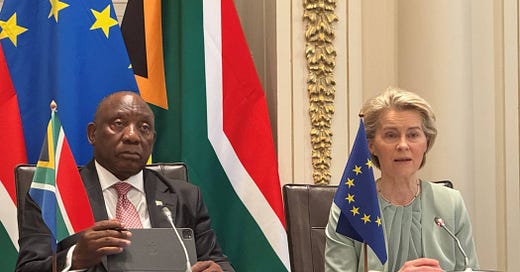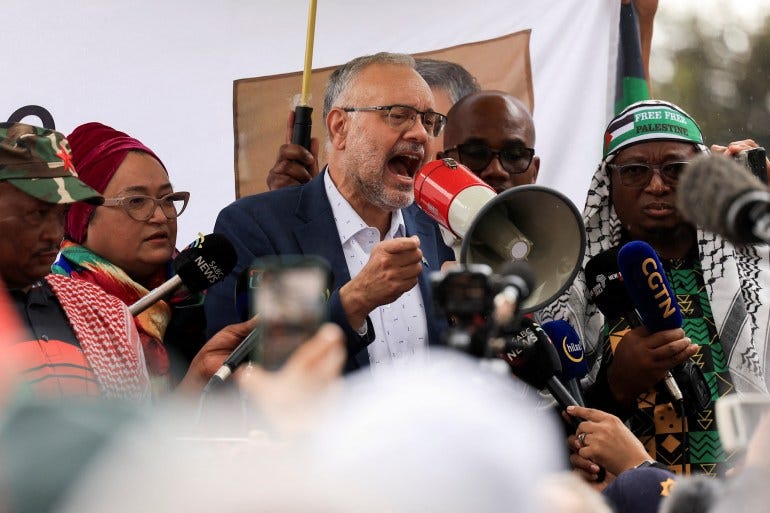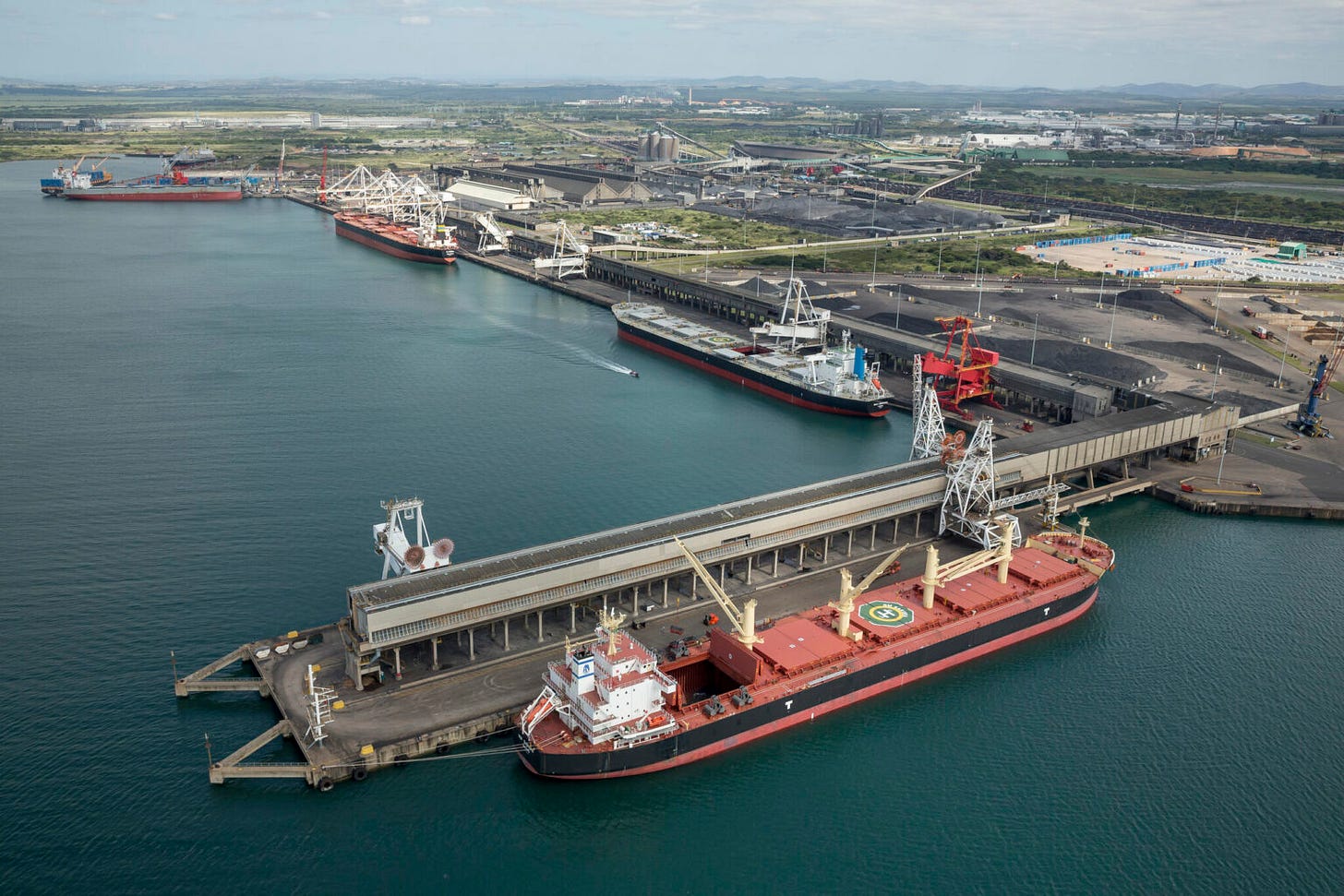Every now and then, a diplomat gets expelled. Declared persona non grata. Usually, it makes a headline or two and then disappears into the diplomatic memory hole.
Not this time. A few days ago, South African Ambassador Ebrahim Rasool arrived back in Cape Town to a hero’s welcome. Hundreds of supporters greeted him at the airport—singing, chanting, waving ANC flags—turning a diplomatic snub into a national spectacle.
Rasool was kicked out of Washington by the Trump administration after a very public war of words. Rasool said Trump was “mobilising a supremacism” as the white population in the U.S. headed toward minority status. The expulsion followed a U.S. executive order from February 7, which cut all U.S. aid to South Africa. The White House cited “unjust racial discrimination” against white Afrikaners and accused Pretoria of siding with Israel’s enemies and cozying up to Iran. Under Trump 2.0, relations have cratered.
Into the void left by American disengagement steps the European Union. Or at least it tries to.
Sneaking In
A few weeks ago, during the eighth EU–South Africa summit in Cape Town, European Commission President Ursula von der Leyen unveiled a €4.7 billion investment package aimed at helping South Africa “achieve a clean and just energy transition.” Hydrogen projects would be funded. A green industrial miracle, Brussels hopes, is just over the horizon.
“We know that others are withdrawing,” von der Leyen said, taking a not-so-subtle jab at Washington. “We are here to stay.” South African President Cyril Ramaphosa echoed the sentiment, calling for a “mutually beneficial partnership.”
For the EU, this partnership is more than symbolic. South Africa holds 91% of the world’s platinum group metal reserves, which are essential for green hydrogen production. These metals (platinum, palladium, rhodium) are used in electrolyzers, a key pillar of the EU’s hydrogen-heavy energy agenda.
South Africa has also one of the world’s largest manganese reserves, a critical raw material required for batteries. And it ranks among the world’s top producers of copper, nickel, vanadium, and titanium. Each critical or strategically important to modern energy and industrial supply chains.
The EU is dependent on this supply. For example, South Africa provides 71% of the EU’s needs for platinum and an even higher share of the platinum group metals iridium, rhodium, and ruthenium.
The vision is ambitious: help South Africa become a global leader in clean energy, “from wind to sun,” as von der Leyen put it. And in turn, lock in long-term access to the raw materials needed to sustain Europe’s energy transition. A Memorandum of Understanding is expected to be signed at the South African G20 summit in November.
But beneath the talk of solidarity and sustainability lies something more pragmatic: the EU’s own clean tech sector is struggling. Financing green energy projects abroad could help prop up this industry and provide demand that’s crumbling everywhere else.
But the whole thing is doomed from the start. Let’s explore why.
Moving Up The Value Chain
The EU’s vision faces a basic problem: South Africa’s grid is falling apart.
In February, the country plunged back into Stage 6 power cuts, meaning 6,000 megawatts were taken offline. Eskom, the state-owned utility that generates roughly 90% of the country’s electricity, most of it from coal, blamed the crisis on a wave of unexpected unit failures, coupled with nearly 7,000 megawatts offline for planned maintenance.
For nearly a year, Eskom had managed to hold rolling blackouts at bay thanks to major repairs across its ageing coal fleet. But the reprieve didn’t last. At the height of the crisis, the South African Reserve Bank estimated the economic toll at 899 million rand per day (about $49 million).
The blackouts weren’t just an inconvenience. They helped sink the ANC’s electoral majority for the first time since the end of apartheid. But more importantly, they prevent the country from moving up the value chain.
South Africa is a global heavyweight in critical and strategic minerals. But right now, it exports most of those raw materials abroad. In 2022, 63% of South Africa’s mineral exports went to China where they’re refined, processed, and turned into higher-value products.
Pretoria doesn’t want that to continue. It wants to do the processing at home, to capture more value, create industrial jobs, and reduce dependence on foreign supply chains. But obviously you can’t run a refinery on load-shedding. And you won’t climb the economic ladder while the power grid collapses beneath you.
And this tells you all you need to know to understand why Europe’s green phantasy in South Africa is dead in the water.
Exporting Intermittency
According to the European Commission, it wants to invest €4.7 billion to “scale up renewables in Africa.”
But that much-touted package isn’t a donation. It’s a mix of loans and financial instruments that South Africa will eventually have to pay back. Brussels isn’t handing over free solar panels and electrolyzers. It’s extending credit, with strings. Not everyone is impressed. Deutsche Welle quoted Dr. Ongama Mtimka, a political economist at Nelson Mandela Bay University:
There are aspects of the energy transition that have neo-colonial tendencies. And these neo-colonial tendencies are evident in attempts to recolonize a country in the green energy grid.
You don’t need to agree with that framing to see the core problem: Why would South Africa borrow billions to build an energy system that has already made Europe poorer?
J.P. Morgan doesn’t sugarcoat it. In their latest Annual Energy Paper, they write:
Europe is the world leader with respect to the pace of decarbonization […] However, Europe is paying a steep price for this transition. Its energy prices have risen from 2x to 4x US levels, and its residential electricity prices are now 5x–7x higher than in China and India. There have been many articles on European deindustrialization due to rising absolute and relative energy costs.
So here’s the absurdity: Europe wants to lend South Africa money to build the same energy infrastructure that is crippling its own competitiveness.
And South Africa, which is on the verge of moving up the industrial value chain, of building its own mineral refining capacity, needs more stability, not less. Cheap, dispatchable energy. Not grid-choking intermittency.
If anything, Europe’s pitch makes less and less sense the more seriously South Africa takes its own development.
Follow the Ladder
If you want to predict how this story ends, forget the press releases. Just look at the physics: Every country that moves up the value chain does so by climbing the energy ladder. From diffuse, low-density sources to concentrated, high-density ones. No exceptions. No shortcuts.
Britain, Germany, the U.S., China all industrialized on coal, oil, and gas before adding nuclear to the mix. That’s how you power smelters, refineries, and factories. That’s how you run high-uptime processes and grow GDP per capita.
South Africa, for now, still runs on coal. Despite the costs and emissions, that coal has kept its industrial base alive. The next logical step is natural gas. After that, nuclear. And whether Brussels likes it or not, that’s exactly the path South Africa is already taking. Because while Brussels talks hydrogen, Pretoria is building gas infrastructure.
A More Serious Foundation
South Africa recently signed an operator agreement for its first LNG terminal, to be located at Richards Bay, just north of Durban on the Indian Ocean coast. The facility will be developed by Transnet National Ports Authority (TNPA) and Royal Vopak, targeting a startup date of 2028. Initial throughput is expected to hit 2 million tonnes per year, with capacity scalable to over five million.
The project is central to South Africa’s energy survival. The LNG terminal will include a floating storage unit, an onshore regasification system, and later dedicated onshore storage. Eskom has already begun planning for coal-to-gas conversions at its legacy power stations.
The LNG terminal could end South Africa’s load shedding. Gas-to-power is expected to bring a 6,000 megawatts capacity online, which should be enough to minimize blackouts.
Other import terminals, such as the one proposed at the Port of Ngqura, are still in the planning phase, and several offshore drilling projects are currently under consideration for exploration.
Meanwhile, Mozambique, just next door, is positioning itself as a major LNG hub. But tapping into that gas will require new regional infrastructure and trade agreements, many of which still haven’t been finalized.
What about the cost of actual generation capacity? In 2023, the U.S. Energy Information Administration estimated the construction cost of combined cycle gas turbines at $894 (€830) per kilowatt. That means the €4.7 billion the EU wants to lend South Africa could fund over 5,600 megawatts of stable, dispatchable capacity. Almost the same amount of capacity Eskom had to pull offline in February to keep the grid from collapsing.
Granted, U.S. figures don’t translate perfectly to South Africa. But they offer a benchmark. And the point is clear: for the same money, South Africa could build a serious foundation of reliable power, not just a green experiment.
The U.S. Vision Without the U.S.
While gas is the immediate priority, South Africa hasn’t given up on nuclear. The government recently reaffirmed its commitment to nuclear energy and announced plans to revive the Pebble Bed Modular Reactor (PBMR) programme, with new builds also on the table.
Originally based on German designs, the PBMR has been in development since the 1990s. It was once seen as a flagship technology. After years of dormancy, Pretoria now wants to bring it back. Of course, that will take time. And until then, natural gas remains the only realistic bridge between coal and a stable, low-emission future.
Here’s the irony: South Africa’s energy strategy mirrors the exact energy vision the U.S. says it wants for Africa. In a recent speech at the Powering Africa Summit in Washington, U.S. Energy Secretary Chris Wright framed it this way:
From LNG to small modular reactors, we see an Africa that boldly embraces every form of energy and energy technology, bar none, with each nation tailoring its energy choices to its people’s needs.
With Europe offering ideology instead of infrastructure, and the U.S. sidelined by politics, there’s only one major power left in the game: China. Chinese companies are already deeply embedded in the region’s energy landscape. In Mozambique, they’re involved in upstream gas production, pipeline construction, and financing, laying the groundwork for future cross-border energy flows.
If Brussels refuses to back gas infrastructure because it doesn’t fit the climate narrative, Beijing won’t hesitate. It has the capital, the construction capacity, and, most importantly, the pragmatism. That’s how it locks in long-term access to South Africa’s minerals. Processed, profitable, and out of Europe’s hands.
Signal Vs. Noise
South Africa is standing at a crossroads between ideology and realism. The EU wants it to borrow billions for the same tech that’s turning Europe into a cautionary tale. The U.S. has the right ideas but has walked off the field. And China is waiting with a blank check and a construction crew. South Africa doesn’t need saving, it needs power. The country is choosing gas and nuclear because they work. That’s how you build industry and move up the value chain. Investors would be wise to follow South Africa’s lead. And ignore the noise from Brussels.
Send this to the last person who said you could take shortcuts!







Yet another Euro Double-Down Energy Debacle.
Reminds me of the Biden Administration giving oil rich Angola our tax dollars for solar development.
Excellent take on the South African situation.
EU involvement is another green policy gimmick. Instead of offering a long-term solution to Eskom's infrastructure issues, the EU adds more instability in the grid with renewables.